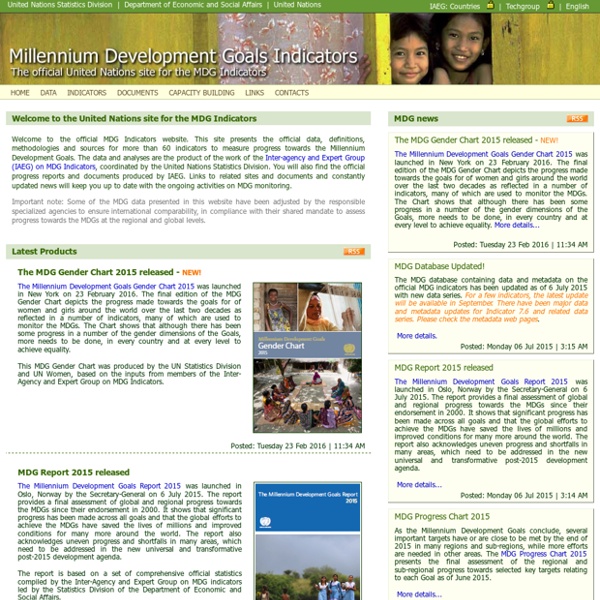



http://mdgs.un.org/unsd/mdg/Default.aspx
Indicadores ODM & Desenvolvimento - UN: Global poverty rate is decreasing but progress is yet to be felt by the most vulnerable in society - Eurostep The UN launched its annual report on the state of progress of the Millennium Development Goals (MDGs) this week. The report argues that whilst global poverty rates are falling, progress has been uneven and achievement of some of the MDGs is still lagging behind — particularly in the poorest nations. The UN Millennium Development Goals Report 2011 argues there has been huge success in many of the 8 goals. The report states, the overall poverty rate is expected to fall below 15% by 2015 — well below the 23% target set in the MDGs. This would meet the target of the first MDG 1 of halving the proportion of people living on less than $1 day.
UK Open Data Institute (Silicon Roundabout) Posted by Information Age on 28 November 2011 Share article 0googleplus Short of time? Print this pageEmail article Global Economic Prospects Source: World Bank. Notes: e = estimate; f = forecast. EMDE = emerging market and developing economy. The World Factbook People from nearly every country share information with CIA, and new individuals contact us daily. If you have information you think might interest CIA due to our foreign intelligence collection mission, there are many ways to reach us. If you know of an imminent threat to a location inside the U.S., immediately contact your local law enforcement or FBI Field Office. For threats outside the U.S., contact CIA or go to a U.S. Embassy or Consulate and ask for the information to be passed to a U.S. official. Please know, CIA does not engage in law enforcement.
Harvard - Online Data Sources Online Data Sources Political Governance Stability Corruption Indicadores ODM & Desenvolvimento - Indicators This page in: Indicators Agriculture & Rural Development Aid Effectiveness World Development Indicators The primary World Bank collection of development indicators, compiled from officially-recognized international sources. It presents the most current and accurate global development data available, and includes national, regional and global estimates. TypeTime seriesPeriodicityAnnualLast Updated01-Feb-2017Economy CoverageWLD, EAP, ECA, LAC, MNA, SAS, SSA, HIC, LMY, IBRD, IDAGranularityNational, RegionalNumber of Economies217TopicAgriculture & Rural Development, Aid Effectiveness, Climate Change, Economy & Growth, Education, Energy & Mining, Environment, External Debt, Financial Sector, Gender, Health, Infrastructure, Labor & Social Protection, Poverty, Private Sector, Public Sector, Science & Technology, Social Development, Trade, Urban DevelopmentUpdate FrequencyQuarterlyUpdate ScheduleApril, July, September, DecemberContact Detailsdata@worldbank.orgAccess OptionsAPI, Bulk download, Mobile app, Query toolAttribution/citationWorld Development Indicators, The World BankCoverage1960 - 2016
International Programs - Information Gateway Frequently Asked Questions (FAQ) 1. What is the International Data Base? The International Data Base (IDB) offers a variety of demographic indicators for countries and areas of the world with a population of 5,000 or more. World and Region demographic indicators in the IDB, including population totals, exclude the populations of countries and areas with fewer than 5,000 people. The IDB has provided access to demographic data for over 25 years to governments, academics, other organizations, and the public.
Prediction market People who buy low and sell high are rewarded for improving the market prediction, while those who buy high and sell low are punished for degrading the market prediction. Evidence so far suggests that prediction markets are at least as accurate as other institutions predicting the same events with a similar pool of participants.[1] History[edit] Prediction markets have a long and colorful lineage. Betting on elections was common in the U.S. until at least the 1940s, with formal markets existing on Wall Street in the months leading up to the race.
Indicadores ODM & Desenvolvimento - Sanitation Sanitation is the hygienic means of promoting health through prevention of human contact with the hazards of wastes as well as the treatment and proper disposal of sewage wastewater. Hazards can be either physical, microbiological, biological or chemical agents of disease. Wastes that can cause health problems include human and animal feces, solid wastes, domestic wastewater (sewage, sullage, greywater), industrial wastes and agricultural wastes. Hygienic means of prevention can be by using engineering solutions (e.g. sewage and wastewater treatment), simple technologies (e.g. latrines, septic tanks), or even by personal hygiene practices (e.g. simple handwashing with soap). The World Health Organization states that: "Sanitation generally refers to the provision of facilities and services for the safe disposal of human urine and feces.